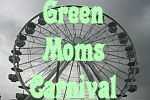Earth Day & Graham Crackers
“Mama, can you fix my graham cracker?”
It was a plaintive question from a small voice in the back of the car. As parents, our instinct is to help our kids whenever we can. But sadly, I had to explain that some things — like broken graham crackers — can’t be fixed.
No sooner had I responded than it hit me. With Earth Day reminders all around us, I couldn’t help but take that question and apply it to the environment. How much of the environmental degradation will we be able to fix? What is reversible, and what is not ?
The answers are not simple.
And as Earth Day continues its metamorphosis into a Buy Green Holiday, it’s important to recognize that we can’t buy our way out of this mess. Sure, investments in certain areas can help, as can replacing toxic products with eco-friendly substitutes.
But what would happen if we all took a close look at our local environmental issues and tried to figure out what we could do to fix things? Here are a few things you do:
– Clean up the litter in a local park or along a river, as these people do in DC’s Rock Creek;
– Plant a tree or take inspiration from this 21-year-old and support a reforestation program;
– Support one of the many fine environmental organizations trying to make a difference in this tough economic environment. Some of my faves: The Nature Conservancy; Environmental Working Group; and Healthy Child, Healthy World. Others? The local groups working hard to make a difference in your own backyard. Here in the DC area that means groups like Friends of Rock Creek, The Chesapeake Climate Action Network, and Bethesda Green.
What have you fixed recently? Leave a comment and share. Really, I want to hear what you’ve been up to! Haven’t done anything lately? Hmm…quit surfing the ‘Net and get moving!
— Lynn
Copyright OrganicMania 2009
Filed under Green Charities, Green moms, Holidays | Wordpress Comments (10) |The Aftermath of the Green Moms Carnival: Hysterical Mommy Bloggers?
By now, I thought my mind would be on blogging about Tips for an Eco-Friendly Easter. But instead, I keep thinking about how the personal care products industry responded to the concerns raised by last week’s Green Moms Carnival. The Green Moms asked questions about the safety of the tens of thousands of untested, unregulated chemicals used in personal care products such as shampoos and household cleaners, and the presence of small amounts of probable carcinogens such as 1,4 dioxane and formaldehyde in products such as baby wash.
The industry’s response was to:
1) ignore our questions – even when we telephoned;
2) send out form emails like this one that didn’t address our questions; and
3) engage this “crisis management” PR firm to leave comments on our blogs alleging that both the Green Mom bloggers and the Campaign for Safe Cosmetics and the Environmental Working Group, the environmental groups behind the studies, were “irresponsible,” were causing “hysteria,” and suggesting that we needed to do more “critical thinking.”
Check out my friend Jennifer Taggert’s post, “Oh, don’t worry, you’re just a mommy blogger & just a little bit of a carcinogen is okay.” Read the comments.
Prior to the carnival, I was a bit skeptical of the need for the Kid Safe Chemicals Act. Because Ad Age recently reported on J&J‘s new social media campaign and their desire to “deepen engagement” with Mom bloggers, I expected they would welcome a call from a blogger asking for J&J’s perspective prior to publishing a blog post. Regrettably, that was not my experience with J&J, nor with the Personal Care Products Council.
I hoped that my efforts to reach out to industry before publishing my post for the Green Moms Carnival would lead to more confidence in the state of the industry and the existing regulatory system, not less confidence.
As Mary Hunt says here, “I find it amusing that if women are surveyed by a paid for research firm, their answers are sanctified and considered valid feedback. But if women give the same opinions freely on the web without “being asked,” then they are hysterical or overreacting. The only difference is that someone in the middle was paid to ask the question. Go figure.”
Happy Easter, Happy Passover, everyone. I’m going to try to go off and focus on dying eggs the natural way. I’ll try not to eat too much Fair Trade Easter chocolate. But this isn’t over. If anything, the industry’s response to our concerns has galvanized us to action.
Lynn
Copyright 2009 OrganicMania
Filed under Baby, Cancer, Green Cleaning Products, Green moms, Organic Personal Care Products, Product Recommendations | Wordpress Comments (21) |It May Be April Fool’s Day, But Toxins in Baby Bath are No Joke
It sounds incredible: probable human carcinogens like formaldehyde in children’s bubble bath. Yes, today is April Fool’s Day, but this is no joke. This is the sad reality of the state of our personal care products industry.
How did we get to this point? It’s a function of our regulatory system (or lack thereof as some might say). According to the non-profit Environmental Working Group, “The nation’s toxic chemical regulatory law, the Toxic Substances Control Act, is in drastic need of reform. Passed in 1976 and never amended since, TSCA is widely regarded as the weakest of all major environmental laws on the books today. When passed, the Act declared safe some 62,000 chemicals already on the market, even though there were little or no data to support this policy. Since that time another 20,000 chemicals have been put into commerce in the United States, also with little or no data to support their safety.”
And if this is news to you, you may be asking why you’re learning about this only now. The Campaign for Safe Cosmetics just last month released its “No More Toxic Tub” report, which included lab results showing that personal care products are commonly contaminated with formaldehyde or 1,4-dioxane – and, in many cases, both. According to the report, “These two chemicals, linked to cancer and skin allergies, are anything but safe and gentle and are completely unregulated in children’s bath products.”
But you know what? This isn’t new news. It may be new to you because perhaps you’re a new parent who is just for the first time paying careful attention to what goes into the bath water with your baby. But the fact is, you can find reports like this one about 1,4 dioxane and formaldehyde dating back to 2007 – and I imagine, even earlier. (Updated 4/3: Here’s a link reporting that in 1982, “the industry-funded Cosmetic Ingredient Review panel noted that the cosmetic industry was aware of the problem of 1,4-dioxane in cosmetics and was making an effort to reduce or remove the impurity.” )
The makers of these products claim they are completely safe and meet all government requirements. J&J’s products are bearing the bulk of the criticism from today’s Green Moms Carnival because of J&J’s ill-timed “Big Bubblin Stars” video campaign. But the fact is, J&J does meet all US requirements. Levels of formaldehyde in the J&J products are even below EU levels, which is significant because many American consumers try to follow EU standards for personal care products because they believe them to be safer than the US standards.
But the issue is not J&J’s products alone. Why? We are exposed to thousands of personal care products over our lifetimes. If each one of these products leaches trace amounts of potentially toxic chemicals into our bodies – as tests like the EWG’s “Body Burden” test have shown – then the effect is a cumulative one. And when you’re talking about infants, small children, and young people in their reproductive years, the potential effects are really unknown. We do know that chemicals have been linked to cancers. We do know that we’ve seen a marked decrease in fertility in this country and an increasing number of reproductive diseases. Are they connected to repeated chemical exposures from birth on? I agree with Dr. Philip P. Landrigan, Professor and Chair of the Children’s Environmental Health Center at New York’s Mount Sinai School of Medicine. He says, “Children are not simply ‘little adults’. They are uniquely vulnerable to toxic exposures in the environment. Exposures in early life can affect human health over the entire life span. We need to find definitive answers about the relationship between toxic chemicals and health so we can protect our children now and in the future.”
In response to past criticism, J&J’s spokesperson Iris Grossman has said, “It’s important to stress that all our products are within the FDA limits.” But that’s just the problem. Are the FDA limits appropriate? Unfortunately, one of the legacies left us by the Bush Administration is the public’s fundamental distrust of our regulatory system. The public has just been burned too many times by lax oversight. Look at our financial markets. The SEC claims it wasn’t aware of the extensive use of derivatives in our secondary markets. Heck, I remember learning about derivatives way back in ’97 when I was at Georgetown’s Business School. No, I didn’t understand them, but I still remember scribbling this note: Derivatives: Stay Away!!! Then there’s the sad state of our food safety oversight. How many more people will have to die of salmonella before we get that under control? What about the lead in children’s toys? I shouldn’t have to cart my toys over to The Smart Mama for a thorough lead inspection.
Many will advocate for more regulation, such as the Kid Safe Chemical Act supported by the Environmental Working Group. But regulations don’t always work as intended. The CSPIA, enacted to prevent the sale of items containing lead, has inadvertently caused many small makers of children’s products to go out of business because they couldn’t afford to comply with the testing requirements imposed by the new law. Then there’s the response to the banking crisis. While the government was celebrating the passage of TARP, the bankers were celebrating the fact that the law didn’t require them to start lending again. How do I know that? I first learned about it at a Washington Christmas party, well before that scandal had finally hit the press. And now that spring is here? The credit markets still remain frozen.
So is The Kid Safe Chemical Act the answer? Will it cause more problems than it purports to solve? Will it inadvertently cause harm to the natural and organic purveyors, by causing them to comply with burdensome regulation, just like what happened when the USDA Organic regulation and the CSPIA was passed? I don’t know. I don’t claim to be a regulatory expert. But I do know something about marketing. And I know that the profit margins on personal care products – beauty products in particular – are incredibly high. It is a very lucrative business, and in most cases the biggest expense is not producing the product, it’s marketing. It’s paying for all the free samples and glossy magazine ads that personal care products companies routinely hand out.
Of course, it’s a different matter in the natural and organics market. There, the cost of all natural alternatives to synthetic chemical ingredients is high. And consequently, on a percentage basis, they spend less on marketing than companies like P&G or J&J.
As an MBA and a New Jersey native, I have very dear friends who have worked at leading personal care companies like J&J, Bristol Myers Squibb, and P&G. Of course they believe their products are safe and comply with US law. But that’s not the whole issue. Someone – either the personal care industry as a whole – or the US government – needs to take a closer look at the 82,000 chemicals used in our personal care products to assess the likelihood that they are contributing to our sky high cancer rates and the increasing incidence of reproductive abnormalities.
And as a former newspaper reporter, I know that there are two sides to every story. So I called J&J before publishing this blog post. I wanted to understand their stance on the Kid Safe Chemical Act and the possible adverse affects of long term exposure to the multitude of chemicals in our personal care products. Their spokesperson, Iris Grossman, could not respond to these questions, although she did offer to put me in touch with their “Mommy blogger” person. I pointed out to her that if she couldn’t answer my question, I didn’t think a “Mommy blogger” specialist could either. Then the shock set in. As a marketing and communications professional, I know that every company has a set of standard Q&As used to respond to the media. I asked her if this meant that NO ONE had ever asked these questions before:
– What is J&J’s stance on the Kid Safe Chemical Act?
– What does J&J think about the adverse affects of long term exposure to the thousands of chemicals used in personal care products?
– Is this issue even being discussed at the industry level, through groups like the Personal Products Council?
So what can you do? Here are a few choices:
1. Sign this petition in support of the Kid Safe Chemical Act.
2. Fill out this web form to contact J&J and tell them you want them to lead an industry-wide effort to overhaul the Toxic Substances Control Act. Or, leave a comment on the J&J blog.
3. Contact the Personal Care Products Council here and tell them you expect a better response to the EWG report than the one that their Chief Scientist gave US News & World Report. “These are issues that have been around for many, many years, so it’s not new news. The thing that impressed me was the low levels of dioxane that were found in these products, which indicates to me that the industry is doing its job in keeping this potential contaminant down to a low level.” (And yes, I’ve called the Personal Care Products Council and am just waiting for a call back).
4. Check the EWG’s Skin Deep data base to find safer alternatives to the products identified in the Campaign’s report.
5. Use fewer personal care products and try to find those with fewer, simpler ingredients.
6. Contact your Congressional representatives to let them know you support Kid Safe. Support is especially critical in Pennyslvania and California. This press release from Senator Lautenberg’s office includes good background information on the bill. If you or someone you know lives in PA, check out this link.
If you live in CA, check out this link.
What do you think? Please leave a comment and share. And if you want to talk about the issue, I’ll be on the radio today along with Jennifer Taggert, The Smart Mama, and Lisa Frack of the Environmental Working Group. You can listen to us here and call in with questions at (530) 265-9555.
Thanks for reading this far! This was a longer than usual post, but I felt I needed the space to make these arguments.
— Lynn
Copyright OrganicMania 2009
Filed under Green Cleaning Products, Green Ideas & Stuff, Green moms, Marketing, Organic Personal Care Products, Organic Product Needs, Product Recommendations | Wordpress Comments (17) |5 Tips for Observing Earth Hour with Kids: Get More than an Earth Minute!
Last year, my grand plans for Earth Hour were derailed by the reality of life with little kids: as I blogged here, I ended up with an “Earth Minute.”

This year, I’m determined to learn from the past and enjoy a less rushed and stressed experience. Here are five tips that I’m hoping will make for a more enjoyable family experience. Let me know what you think. How’d your Earth Hour go last year? And what are you planning tonight? (Yes, it’s tonight!)
1. Stick to Your Routines
Clearly, whoever dreamed up Earth Hour did not have little munchkins to put to bed. 8:30 p.m. is simply too late for most kids. If your tykes hit the hay well before 8:30, DON’T, repeat DON’T try to do something special. Odds are, you’ll regret it…
2. Pick a Substitute Time that Works for You
This year, we’re going to have our Earth Hour during dinner (candlelight dining with my three boys should be fun!). If that doesn’t seem to go well, I may try for a few minutes after dinner. But bedtime – it’s still 8 p.m., Earth Hour or not!
3. Use this as a Teachable Moment
My first grader’s school observed Earth Hour on Friday. When I asked him why they did it, he said, “To help the Earth and stuff.” Yet when I tried to make a correlation between Earth Hour and turning off the lights in his room before he rushes off for school, he didn’t quite seem to get it. That’s another reason to do Earth Hour at the dinner hour – it will give us time and context for a discussion about why we are observing Earth Hour.
4. Give Yourself a Break
If despite all your plans, things still go awry, give yourself a break. When I look back at this photo of my little Boo Bear a year ago, I can’t believe how small he was and how much I tried to accomplish despite that. So many of us parents – especially the Moms – are guilty of this. We simply try to do too much.
5. Celebrate with Your Significant Other
Another benefit to Tips #1 and #2 is that if you stick to your kids’ bedtime routine, odds are you’ll have some energy to celebrate the darkness of Earth Hour with your significant other and perhaps a bottle of sustainable wine, organic beer, and fair trade chocolate.
Sounds a lot better than last year! I can’t wait…
Tell me about your Earth Hour! Leave a comment and share!
Lynn
Copyright 2009 OrganicMania
Filed under Easy Green Weekend Projects, global warming, Green Ideas & Stuff, Green moms, Holidays, Parenting, Tips | Wordpress Comments (4) |More on Spring Cleaning: Green Moms Carnival is Up!
Be sure to check out the more than twenty submissions about green ways to clean at this month’s Green Moms Carnival on Spring Cleaning over at Tiny Choices.
— Lynn
Filed under Blog, Green Cleaning Products, Green Ideas & Stuff, Green moms, Green Moms Carnival Home Page & Calendar | Wordpress Comment (0) |The Shortys: Thanks from the Green Moms of Green Moms Carnival
UPDATE: SINCE THIS POST WAS WRITTEN, WE’VE LEARNED THAT IN FACT WE DID WIN THE SHORTY AWARDS COMPETITION! THANKS TO ALL WHO VOTED FOR US AND PLEASE JOIN US IN NYC FOR THE CELEBRATION ON FEBRUARY 11TH!
I’m just recovered from a late night of campaigning for a brand new award: the Shortys. The Shortys aim to honor the best content producers on Twitter. It appears my posse, my community, my gals – the Green Moms of the Green Moms Carnival ended up in second place among all the green twitterati on Twitter. It’s still a bit early to tell, but preliminary results make it look like the winner is Dr. Greene, whom we all adore anyway!
Thanks to everyone who voted for us.
Looking at some of the comments about why people voted was humbling. We’re so thrilled that you enjoy our tweets, learn from them and are inspired by them.
The Green Moms Carnival members are a very diverse group of bloggers who are united by our desire to help Mother Earth. Some of us are Mothers, some of us are child-free. Heck, we’ve even had some “Sons of Mothers” participate in our carnivals!
We’re published authors with popular books in the green space, stay-at-home Moms, law firm partners, business owners, grant writers, Sunday School teachers and non-believers. A few of us were at the forefront of the environmental movement 30 years ago, others came to understand the dangers of environmental degradation far more recently. Some of us blog for the sheer pleasure of it and refuse advertising on our blogs, whereas a few of us support our families with the money made through affiliate programs, advertising, and consulting.
We believe that together, our voices can make a difference in our collective stewardship of Mother Earth.
We thank you for your encouragement.
Members of the Green Moms Carnival: *
- Arduous
- Best of Mother Earth*
- Big Green Purse*
- Crunchy Chicken*
- Crunchy Domestic Goddess
- Eco ‘Burban*
- Enviromom*
- Fake Plastic Fish
- Foodie Tots
- Going Green*
- Gray Matters*
- Green and Clean Mom*
- Green Bean Dreams*
- Green Style Mom*
- Green Talk*
- In Women We Trust*
- Itsabelly
- La Marguerite*
- Milkweed Mercantile/Eco-Village Musings
- Mindful Momma*
- More Green Moms
- Non Toxic Kids
- OrganicMania*
- Surely You Nest*
- The Green Parent*
- Tiny Choices
- The Not Quite Crunchy Parent*
- The Smart Mama*
*Denotes Founding Member
Please join us or help spread the word! (Please bear with us if we don’t respond right away…this is an all-volunteer effort ).
Lynn
Copyright OrganicMania 2009
Filed under Blog, Green moms, Green Moms Carnival Home Page & Calendar | Wordpress Comments (6) |Real vs. Fake Inaugural Invites
Take a look at these Inaugural Invitations. If you received both in the mail, would you know which to use? My neighbors were anxiously awaiting their Inaugural invitations when they received the invitation pictured above. And then, a few days later, they received the second set, pictured at right. When they received the second set, which is the set needed to gain access to the restricted viewing section, they realized that the invite sent by their local Congressman was intended as a general invitation to “attend,” but not the actual coveted tickets they were awaiting. They were a bit less charitable though, and called them “fake.”
What do you think? Are they “fake?”
And as for the actual tickets, gold tassels, gold engraving and all – they’re beautiful. To the right of the invitations are tickets to the Newseum, where yours truly, along with many working members of the press and thousands of fellow citizens will watch the Inauguration on the Newseum’s 40-foot-by-22-foot high definition media screen and in the Robert H. and Clarice Smith Big Screen Theater, where news can be viewed on a unique 90-foot-long video wall. If we can get near the windows, we may watch the parade from there, or try to use our tickets (pictured above, far left) to the parade reviewing stand at 14th and Pennsylvania Avenue.
I hope to be live tweeting from the festivities and then off to a reception on Capitol Hill. It all seems a bit ambitious given the size of the crowds, but here’s hoping it will be worth it! I’ll be tweeting tomorrow from the Green Moms Carnival twitter account @greenmoms. Sign up to follow me there! And if you like what you see, please cast a vote for us in the Shorty Awards! If you have an active Twitter account, you can vote here!
Lynn
Copyright 2009 OrganicMania
Filed under Green moms, Holidays | Wordpress Comments (2) |Check out the Green Moms Carnival: The Holidays
Be sure to stop by The Smart Mama to read a baker’s dozen worth of wonderful posts about the holidays at the latest edition of the Green Moms Carnival. You’ll get insights on everything from reducing your plastic consumption to celebrating the winter solstice.
Come January, the Green Moms Carnival will tackle global warming. The carnival will be hosted by MC Milker at The Not Quite Crunchy Parent. To submit, just send your post to greenmomscarnival at gmail dot com by Monday, December 29th. Although we call ourselves the “Green Moms,” we welcome participation by anyone who’s a friend of a Green Mom! Read more about the carnival here.
— Lynn
Filed under Green moms, Green Moms Carnival Home Page & Calendar, Holidays | Wordpress Comment (0) |10 Tips for Avoiding Recalled Toys
Do you see what’s on that paper lying next to those cute toy trains? A recall notice for those very same trains.
Those My Little Train Toy Classics were so darn cute that I picked one up to admire it. And it was cheap too – less than $2.
But those cheap toys always give me pause. So many of them have been linked to recalls and lead paint. So I decided against purchasing one, even though I’m not prepared to spend loads of money on an all natural, organic alternative.
As I was leaving the store, I noticed a recall notice on the bulletin board near the exit. I picked up the recall notice and ran back to see if these were the same trains. After taking them all down from the display, I brought them over to the customer service desk, showed them the recall notice, and explained that they were selling recalled toys. I expected an apology, or at least an expression of concern from the store personnel…but their response didn’t satisfy me. My immediate reaction was to send out this irate Tweet to my Twitter network.
The next day I called the store manager, and asked him if he was aware of what had happened with the recalled toys the evening prior. He wasn’t. No one had yet bothered to tell him that they had recalled toys on their shelves. He assured me that there was no way I could have purchased a recalled item, because the item would not ring up at the register. He also told me that it was likely that just a lot of the item that was recalled, and that the items on the store shelf were probably fine. Well, no. I checked the Consumer Product Safety Commission website and in fact, all of these toy trains have been recalled due to a choking hazard.
It’s tempting to buy cheap toys – but it’s not worth the risk. They’re often full of toxins (just ask my friend with a toy testing gun, The Smart Mama). And even if they’re safe, they usually don’t last very long before they break.
Few of us can afford to buy all natural, organic toys all the time. So what can you do? Here are ten tips:
1. Before you buy anything, go to the Consumer Product Safety Commission and check the recall list. The notice on the toy trains came out the very day I saw them on the store shelf! (And five more alerts have come out since that one was issued!)
2. Shop consignment stores. You won’t believe the number of high quality wooden toys you can find, some still new and in the original packaging. In the DC area, I like to shop at The Purple Goose and Wiggle Room.
3. Ask your friends for their cast-offs. I have one dear friend in Florida who mails her son’s hand-me-down clothes to us. There’s no reason you can’t get cast-off toys too. (I’d like to get in line for cast-offs from the son of natural toy expert MC Milker of Not Quite Crunchy Parent!)
4. Check yard sales, especially in what my mother used to call “the high rent district.” That’s where you may find gently used, natural and organic toys.
5. Zwaggle is a great source for parents to swap gently used toys.
6. Freecycle is full of environmentally conscious people who love to recycle. These are the same people who are likely to have purchased high quality toys. Post a query requesting your child’s dream toy. Who knows? Maybe you’ll get it for free!
7. Look for discount coupons on line. Simply google the name of the toy and “coupon,” and see what turns up. And here’s an easier way you can save some money on high quality, natural toys. To save 10% off your first order at Natural Pod, just use coupon code GCM08.
But these are only temporary steps. The only way we will keep junk toys out of the store aisles is by exerting pressure on government to strengthen the regulations governing toy safety and inspections. Here’s what you can do:
8. Call or write your Congressional delegation and tell them that you want more resources devoted to the Consumer Product Safety Commission, the agency tasked with ensuring the safety of our children’s toys.
9. Write to your state and local representatives too. States like Washington and Oregon are ahead of federal law it comes to protecting our kids from unsafe toys.
10. Align yourself with organizations that are lobbying the government on behalf of children’s issues. Groups such as Momsrising lobby for passage of laws that help protect kids not only from recalled toys, but from toys containing unsafe levels of chemical toxins.
How are you going to handle toy shopping this holiday season? Leave a comment and share!
— Lynn
Copyright OrganicMania 2008
Filed under Eco-friendly toys, Green moms, Holidays, Marketing, Parenting, Product Recommendations, Tips | Wordpress Comments (10) |Slow Christmas: Fighting Holiday Commercialism
With the holiday season now in full swing, it seems parents everywhere are asking, “How can I make Christmas more meaningful?”
Taking away the focus on crass materialism has never seemed more important, especially now when so many families are suffering in the economic downturn.
For the next few weeks, in addition to posting periodically about alternative gifts, “green gifts” that help the planet and help green entrepreneurs, and experiential gifts, I’ll also post about rediscovering Christmas traditions that bring meaning back to the holiday season.
Take Advent. Yes, Advent. Did you know we’re in the first week of Advent? Advent is a season of waiting. And in our house, the mantra is not “hurry up, rush, shop,” it’s “Slow down. Be quiet. It’s Advent.”
One of my favorite ways of marking Advent is through an Advent calendar. And yes, although we’re technically in the first week of Advent already, it’s not too late to start observing the season of Advent.
Advent calendars mark each day in December up through Christmas Day. They typically tell the story of the Nativity. Some are “permanent” calendars with little doors through which you can hide chocolates or other treats. Others are boxes with the chocolates already hidden inside.
Last year, we made the mistake of buying just one Advent calendar. This year, there are three – one for each of the boys and one for DH and I to share. And yes – you can still find them. Just last night DH picked up the Advent calendars at Whole Foods. We love the the Divine Chocolate calendar – fair trade chocolate from Ghana. And it seems local too, since their corporate offices are right here in DC.
A few years ago, I established a family tradition of leaving the dinner table to read a Christmas story and then enjoy a piece of Advent chocolate.
And every year, I tell myself that we’ll continue the tradition of reading after dinner. Yet somehow by the time December rolls around, we’ve fallen out of the habit of reading after dinner. But it’s a great habit to pick up again each year. So join me – bring out the Christmas books, enjoy a piece of Advent chocolate (just 20 calories!) and Relax. Slow Down. It’s Advent.
– Lynn
Copyright 2008 OrganicMania
Filed under Green moms, Holidays | Wordpress Comments (5) |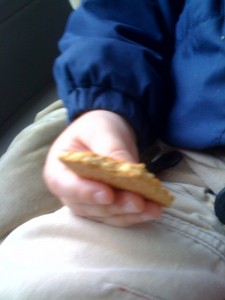
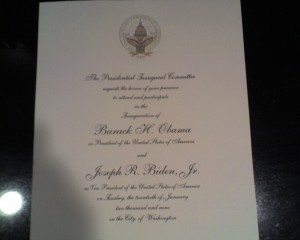
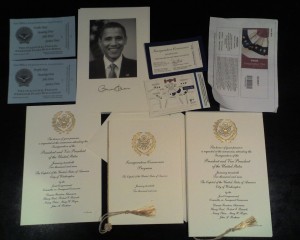
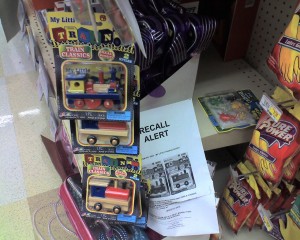
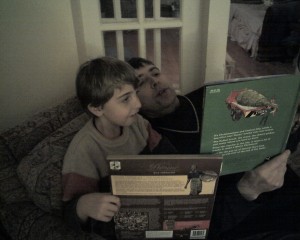
 My StumbleUpon Page
My StumbleUpon Page


